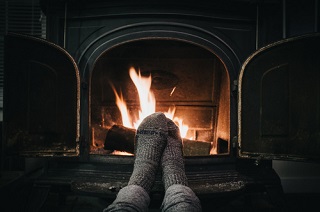From Guest Blogger Bobbi Peterson: Four Eco-Friendly Ways To Heat Your Home This Winter

Traditionally, keeping your house warm and cozy meant burning fossil fuels like coal, oil or natural gas. That’s changing, though, as modern technology discovers new ways of using more sustainable fuel sources for home heating.
If you’re considering revamping your home’s furnace to switch to a more eco-friendly solution, consider these options.
- Pellet Stoves
If you’ve spent any time in a hardware store recently, you’ve probably noticed bags of pellets for sale during the winter. Pellet stoves are a popular new upgrade to wood burning stoves.
Instead of burning traditional firewood, these stoves burn manufactured pellets made of sawdust and other waste from lumberyards. These are a renewable resource and great way to make use of a byproduct that would otherwise go to waste, making them a relatively affordable and green heating solution.
- Masonry Heaters
Masonry heaters are another upgrade to the traditional wood-burning stove. These heaters look like old-fashioned fireplaces built with stone or brick, but they’re specially designed with airways to store heat and slowly radiate it back into your home over the course of many hours.
Because these systems reduce heat loss, they allow you to burn less fuel to reach and maintain your desired temperature — and using less fuel is always a worthy environmental goal.
- Active Solar Heating
A solar-powered heating system typically harness the power of the sun to heat a liquid, which is then forced through an existing heating system, such as radiant floor heating or forced hot water baseboards. These systems can be cost-effective in cold areas that receive predictable amounts of sunlight, and they produce zero carbon emissions, which makes them one of the most environmentally friendly ways to heat your home.
Some communities offer rebates for installing them, so be sure to check your state and local tax codes to see if you qualify.
- Geothermal Heating
Geothermal heating systems harness the steady temperatures of the area beneath your home to reduce home heating costs. In the winter, cold air is pumped out of your house and into the ground, where the soil insulates the air and keeps it warm. Warmer air is then forced back into your house, which requires less energy to heat to your desired temperature than the icy air right outside your windows.
Geothermal systems cut down on the overall amount of heating energy you use, though they can be expensive to install.
Other Options
Though all options are on the table with new construction, your home heating system choices may be limited when you’re retrofitting an existing house. If replacing your entire system is too costly, or if your location or neighborhood limits in your fuel sources, you can still work to make burning traditional petroleum products more eco-friendly.
First, consider the type of fuel you burn by comparing the cost of oil and propane, or oil and natural gas, to discover which burns most efficiently and is most affordable in your area.
Before choosing a new furnace, you can also make any heating system more efficient by insulating your home and replacing windows to stop drafts so your furnace doesn’t have to work so hard. Even adding weather stripping and cellular blinds can help reduce your fuel usage to heat your home in an eco-friendlier way.
Be sure to research all of your options to come up with a home heating plan that’s both green and affordable for your home.
